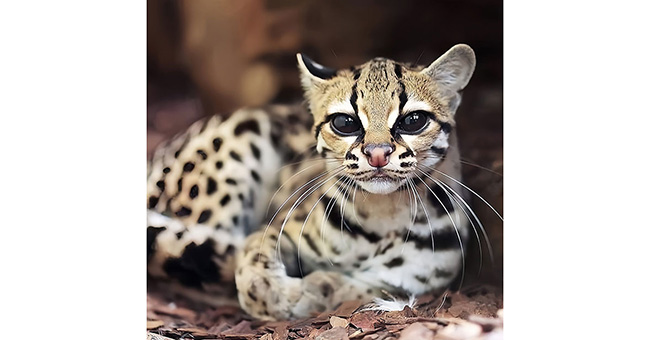Margay Leopardus wiedii
The Margay (Leopardus wiedii) is a remarkable and rare wild cat of the dense rainforests of Central and South America. Its beautiful appearance, agility, and extraordinary tree-climbing abilities distinguish it from other wild cats. This small animal, hidden in the shadows of deep forests, is so shy and nocturnal that seeing it in the wild is extremely difficult.
Physical Structure and Appearance
The Margay has large, round, and very bright eyes—perfect for hunting at night. Its ears are black with white spots on the back, helping it communicate quietly with other Margays. Strong and flexible legs make it a skilled climber, and its long tail helps maintain balance.
It looks similar to the larger ocelot (Leopardus pardalis), but has a slightly shorter head, bigger eyes, and longer legs and tail. It weighs between 2.6 and 4 kg (5.7–8.8 lbs), with a body length of 48–79 cm (19–31 inches) and a tail length of 33–51 cm (13–20 inches). Unlike most cats, female Margays have only two teats.
Its fur is light brown, patterned with rows of dark brown or black rosettes and longitudinal streaks. The underside ranges from pale buff to white, and the tail has multiple dark bands with a black tip. The back of the ears is black with a circular white spot in the center. These markings help it camouflage in its natural environment.
Extraordinary Climbing Skills
The Margay is the only cat species able to rotate its hind ankles up to 180 degrees. This rare adaptation allows it to climb down trees headfirst—something ordinary cats cannot do. It can leap between trees and move along branches like a spider. As a result, the Margay spends most of its life in trees.
Habitat and Range
The Margay’s range extends from Mexico’s tropical lowlands through Central America to Brazil and Paraguay. In Mexico, it has been recorded in 24 of 32 states, from the coastal lowlands and Sierra Madres to the northern border with the United States in Coahuila, Nuevo León, and Tamaulipas, and west to southern Sonora.
Its southern range reaches Uruguay and northern Argentina. It lives almost exclusively in dense forests—from tropical evergreen and dry forests to high cloud forests. Sometimes, it can be found in coffee and cocoa plantations.
It inhabits the dense Amazon rainforest, mountainous forests, and moist evergreen regions. Highly solitary and territorial, each Margay usually moves within a fixed home range.
Diet
The Margay is a carnivore, feeding mainly on lizards, small mammals (such as rodents), birds, bats, eggs, and occasionally fruit. Since it spends most of its time in trees, it mainly preys on arboreal animals.
It moves silently and launches sudden ambushes. Its night vision is so sharp that it can detect prey with even the slightest movement in the dark.
Behavior and Lifestyle
The Margay is generally nocturnal, active mainly at night. It lives alone, keeping its distance from other Margays. During the day, it rests on high branches.
It is very cautious, clever, and shy. Avoiding human contact, it is rarely seen in the wild.
Reproduction
Margay reproduction is slow. A female gives birth only once a year, usually to a single kitten. The gestation period lasts about 80 days, and the kitten is raised solely by its mother. It starts eating solid food at around two months and reaches maturity at about one year old.
Conservation and Threats
The Margay population is rapidly declining in the wild. According to the IUCN Red List, it is classified as Near Threatened. Its main threats include:
Deforestation and habitat loss
Poaching (especially for its fur)
Capture and trafficking for the pet trade
As a predator, the Margay plays an important ecological role by controlling populations of small animals.
Conservation Efforts
Several conservation organizations and national parks are working to protect the Margay. Raising public awareness, preserving forests, preventing wildlife trafficking, and maintaining ecological balance are crucial for its survival.
The only U.S. record of the Margay was collected before 1852 near Eagle Pass in Maverick County, Texas. It is now considered locally extinct in Texas, and the IUCN lists its presence in the United States as “uncertain.”
The Margay is a unique, mysterious, and exquisitely beautiful wild cat whose survival is under threat. Its life in the rainforest is a remarkable example of nature’s adaptability. Protecting this elusive cat and its habitat is our responsibility—so that it may continue its secret life in the treetops for generations to come.
Sources:
IUCN Red List
National Geographic
WWF (World Wildlife Fund)
Panthera.org

